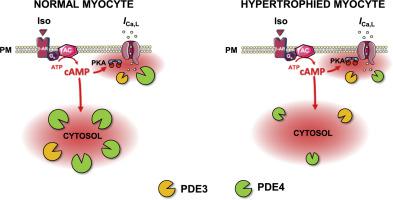Journal of Molecular and Cellular Cardiology ( IF 5 ) Pub Date : 2020-10-25 , DOI: 10.1016/j.yjmcc.2020.10.011 Aniella Abi-Gerges 1 , Liliana Castro 2 , Jérôme Leroy 3 , Valérie Domergue 4 , Rodolphe Fischmeister 3 , Grégoire Vandecasteele 3

|
Background In cardiomyocytes, phosphodiesterases (PDEs) type 3 and 4 are the predominant enzymes that degrade cAMP generated by β-adrenergic receptors (β-ARs), impacting notably the regulation of the L-type Ca2+ current (ICa,L). Cardiac hypertrophy (CH) is accompanied by a reduction in PDE3 and PDE4, however, whether this affects the dynamic regulation of cytosolic cAMP and ICa,L is not known.
Methods and Results CH was induced in rats by thoracic aortic banding over a time period of five weeks and was confirmed by anatomical measurements. Left ventricular myocytes (LVMs) were isolated from CH and sham-operated (SHAM) rats and transduced with an adenovirus encoding a Förster resonance energy transfer (FRET)-based cAMP biosensor or subjected to the whole-cell configuration of the patch-clamp technique to measure ICa,L. Aortic stenosis resulted in a 46% increase in heart weight to body weight ratio in CH compared to SHAM. In SHAM and CH LVMs, a short isoprenaline stimulation (Iso, 100 nM, 15 s) elicited a similar transient increase in cAMP with a half decay time (t1/2off) of ~50 s. In both groups, PDE4 inhibition with Ro-201,724 (10 μM) markedly potentiated the amplitude and slowed the decline of the cAMP transient, this latter effect being more pronounced in SHAM (t1/2off ~ 250 s) than in CH (t1/2off ~ 150 s, P < 0.01). In contrast, PDE3 inhibition with cilostamide (1 μM) had no effect on the amplitude of the cAMP transient and a minimal effect on its recovery in SHAM, whereas it potentiated the amplitude and slowed the decay in CH (t1/2off ~ 80 s). Iso pulse stimulation also elicited a similar transient increase in ICa,L in SHAM and CH, although the duration of the rising phase was delayed in CH. Inhibition of PDE3 or PDE4 potentiated ICa,L amplitude in SHAM but not in CH. Besides, while only PDE4 inhibition slowed down the decline of ICa,L in SHAM, both PDE3 and PDE4 contributed in CH.
Conclusion These results identify selective alterations in cytosolic cAMP and ICa,L regulation by PDE3 and PDE4 in CH, and show that the balance between PDE3 and PDE4 for the regulation of β-AR responses is shifted toward PDE3 during CH.
中文翻译:

心肌肥厚期间磷酸二酯酶对胞质 β-肾上腺素能 cAMP 信号和 L 型钙通道调节的选择性变化
背景在心肌细胞中,3 型和 4 型磷酸二酯酶 (PDE) 是降解 β-肾上腺素能受体 (β-AR) 产生的 cAMP 的主要酶,显着影响 L 型 Ca 2+电流 ( I Ca,L )的调节. 心脏肥大 (CH) 伴随着 PDE3 和 PDE4 的减少,然而,这是否影响胞质 cAMP 和I Ca,L的动态调节尚不清楚。
方法和结果在大鼠中通过胸主动脉束带在五周的时间内诱导 CH,并通过解剖测量证实。从 CH 和假手术 (SHAM) 大鼠中分离出左心室肌细胞 (LVM),并用编码基于 Förster 共振能量转移 (FRET) 的 cAMP 生物传感器的腺病毒进行转导或进行膜片钳技术的全细胞配置测量I Ca,L。与 SHAM 相比,主动脉瓣狭窄导致 CH 中心脏重量与体重之比增加 46%。在 SHAM 和 CH LVM 中,短暂的异丙肾上腺素刺激(Iso,100 nM,15 s)引起 cAMP 类似的瞬时增加,半衰期时间(t 1/2off) 约 50 秒。在两组中,PDE4 用 Ro-201,724 (10 μM) 抑制显着增强了振幅并减缓了 cAMP 瞬变的下降,后一种效应在 SHAM (t 1/2off ~ 250 s) 中比 CH (t 1 /2off ~ 150 秒,P < 0.01)。相比之下,西洛他胺 (1 μM) 抑制 PDE3 对 cAMP 瞬变的幅度没有影响,对其在 SHAM 中的恢复影响很小,而它增强了幅度并减缓了 CH 的衰减 (t 1/2off ~ 80 s )。Iso 脉冲刺激也引起了类似的瞬态I Ca, L在 SHAM 和 CH 中的增加,尽管上升阶段的持续时间在 CH 中被延迟。PDE3 或 PDE4 的抑制增强了I假手术中的Ca,L振幅但 CH 中没有。此外,虽然只有 PDE4 抑制减缓了SHAM中I Ca,L的下降,但 PDE3 和 PDE4 都对 CH 有贡献。
结论这些结果确定了 CH 中 PDE3 和 PDE4对细胞溶质 cAMP 和I Ca,L调节的选择性改变,并表明 PDE3 和 PDE4 之间用于调节 β-AR 反应的平衡在 CH 期间向 PDE3 转移。


























 京公网安备 11010802027423号
京公网安备 11010802027423号